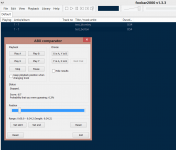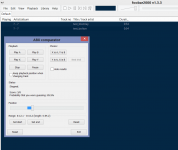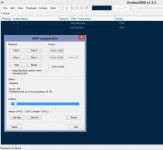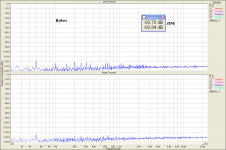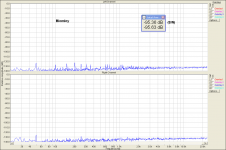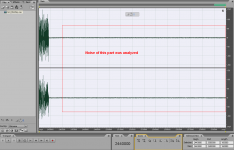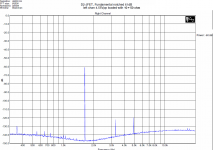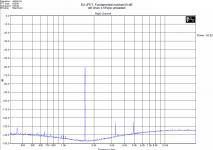Had another listen. Different PC, same headphones. I'm convincing myself here that "B" is the best sounding. I can imagine the notes flying from the piano more, as if its set in a bigger acoustic. Three runs of Foobar.
Edit... so B would be Bolton.
Edit... so B would be Bolton.
Attachments
I could say yes, I heard the difference on the first run concentrating hard.
I agree that in case of slight differences it is very difficult to keep concentration and hearing resolution.
Anyway, the 50 ohm loading did not seem to introduce any harsh artifacts, in this case.
What is interesting, that sometimes people who listen with low-end equipment (like Max said, PC with 1" speakers) are able to tell the "clear difference". However, I greatly appreciate your input, that is supported with ABX foobar results.
However, I greatly appreciate your input, that is supported with ABX foobar results.
Thanks Pavel. Its always interesting trying these kind of things out.
I just learned that Harry Pearson died. RIP, Harry. He was only 77 and started The Absolute Sound. I knew HP and visited him often as my friend Sallie Reynolds, whom I visited at her home in Sea Cliff, lived a short walking distance from Harry's home. Harry bought me the first Audio-System One (maxed out features set) to learn what could be correlated to listening. He was always a gentle man with great tastes in all things. After I stole Sallie away (his TAS editor), he visited me and Sallie in our home in Cool, California as well. Last time I saw him, we all got in the hot tub... Hot tub and wine. Nice in the winter. He will be missed !
-Richard Marsh
I was just looking at that publication the other day. 77 is no age to go nowadays. RIP indeed.
For those of you that are interested, I've finally managed to get the schematics to display correctly in my new preamp write-up here
Ovation Symphony Line Preamplifier
This uses AD797's, LME7910 and LME4562 devices all bootstrapped into class A (~600uA to 1mA) and then driving an in loop discrete class A buffers.
Ovation Symphony Line Preamplifier
This uses AD797's, LME7910 and LME4562 devices all bootstrapped into class A (~600uA to 1mA) and then driving an in loop discrete class A buffers.
Karl, I have used your Direct WAV file to create 2 files, one with unloaded preamp output, second with heavily loaded preamp output. If anyone would like to try and give his opinion which is which, here is the link:
https://www.dropbox.com/s/sndn8jpl5hlfigo/manchester.zip?dl=0
OK, Bolton was unloaded, Blomley was loaded (preamp output loaded with 50 ohm terminating resistor, preamp output impedance is 10 ohm, volume matched by turning the input Alps).
Thanks Pavel.
When I listened I used the method, play A, play A play A, play B (I keep thinking B is better), play X or Y... yes X or Y was B or, I'm not sure, play B, play B play B, play X or Y again and decide. And so on and repeat.
Very tiring when concentrating so hard
When I listened I used the method, play A, play A play A, play B (I keep thinking B is better), play X or Y... yes X or Y was B or, I'm not sure, play B, play B play B, play X or Y again and decide. And so on and repeat.
Very tiring when concentrating so hard
Don't make it too difficult Mooly, or you will make mistakes that will imply that there is no consistent difference. I think that your first simple X-Y test told 90% of what we need to know: That some people, especially people experienced in evaluating listening differences, can hear a difference in similar circuits. " Who could ask for anything more?"
I agree with the technique of repeating one sample over and over again, so that the pattern of sound builds up in your mind; it no longer is music, it almost becomes a rhythmic chant of noise - as soon as that pattern is slightly altered, the mind picks it immediately - there's been a change, and you recognise it instantly ...When I listened I used the method, play A, play A play A, play B (I keep thinking B is better), play X or Y... yes X or Y was B or, I'm not sure, play B, play B play B, play X or Y again and decide. And so on and repeat.
Very tiring when concentrating so hard
A little more exploration of PMA's files, Blomley and Bolton: I had to go to high levels of oversampling to get decent time alignment - 1,536k sampling rate - and at these rates the file sizes become huge, so only looked at Left channel, but called Mono in the image. Adjusted Bolton by 0.07dB, and was able to secure a diff file that lay in the range 60-80dB down.
But looking in the "worst" areas we get this:
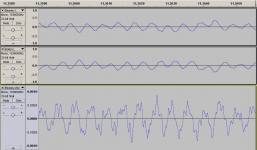
The diff file is effectively only 40 to 50dB down from the source waveform - hence would still be quite audible as a tonal change between the files. And what I find particularly interesting is the shape in the diff file at the crossover regions of the source ...
But looking in the "worst" areas we get this:

The diff file is effectively only 40 to 50dB down from the source waveform - hence would still be quite audible as a tonal change between the files. And what I find particularly interesting is the shape in the diff file at the crossover regions of the source ...
Last edited:
Okay, now we know that Bolton should be the "best", how much does that differ from the original file, Direct WAV ... quite a bit it seems - this is at the spot of biggest difference, at the beginning of the recording:
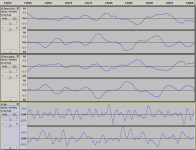
Note that the left, upper, channel seems to be somewhat less accurate, there's more bleedthrough of the source waveform in the right channel, pointing to less distortion.

Note that the left, upper, channel seems to be somewhat less accurate, there's more bleedthrough of the source waveform in the right channel, pointing to less distortion.
Okay, now we know that Bolton should be the "best",
Hi Frank, I am not sure if Bolton is "better" than Blomley. We just have known that Bolton is unloaded. That does not necessarily mean "better". Analysis of the last part of the files, when music ended and whole channel (DAC - preamp - ADC) background noise has been recorded, shows that Blomley has less intrinsic noise. It has higher channel S/N ratio. Differences in harmonic distortion are absolutely negligible.
Also please take into account dithering that Audacity uses always, it is not TPD, but noise shaping dither.
P.S.: you have captured well that the ADC inverts the phase
Attachments
Last edited:
Comparison of distortion of the loaded and unloaded preamp. It is measured at higher amplitude than used in the test, otherwise everything would remain in noise even with narrow band FFT. Measured with notch filter, to see anything. Distortion components have changed from about -125dB (re fundamental) for unloaded to -120dB for loaded preamp. The output stage is biased at 40mA, it is very deeply in class A even if loaded.
Attachments
Don't make it too difficult Mooly, or you will make mistakes that will imply that there is no consistent difference. I think that your first simple X-Y test told 90% of what we need to know: That some people, especially people experienced in evaluating listening differences, can hear a difference in similar circuits. " Who could ask for anything more?"
Yes, some could hear the difference when opamps were loaded far above their specs. This would never happen in at least moderately well designed preamp, provided it was not designed by a garage hi-end enthusiast designer, not educated in EE. We do not load conventional opamps with 100 ohm resistors, do we? We are talking wire distortions, resistor distortions etc., here, right?
Blomley has less intrinsic noise. It has higher channel S/N ratio. Differences in harmonic distortion are absolutely negligible.
What makes this difference in the channel noise? The answer is very easy. The preamp has 10 ohm output resistance. We load it by 50 ohm and get the 50 : 60 ohm divider. Let's take the basic maths:
20 log (50/60) = -1.58 dB.
We had to add 1.58 dB by volume pot for Blomley to get the same amplitude levels of both files. This 1.58 dB is the improvement in S/N for Blomley.
Pavel, are you saying that you used Audacity to do the recording?Also please take into account dithering that Audacity uses always, it is not TPD, but noise shaping dither.
As regards my use of it, all the files are processed at the 32 bit level, i.e. about 190dB dynamic range, with zero dithering applied: choices of dither in Audacity are None, Rectangle, Triangle or Shaped.
- Status
- Not open for further replies.
- Home
- Member Areas
- The Lounge
- John Curl's Blowtorch preamplifier part II
